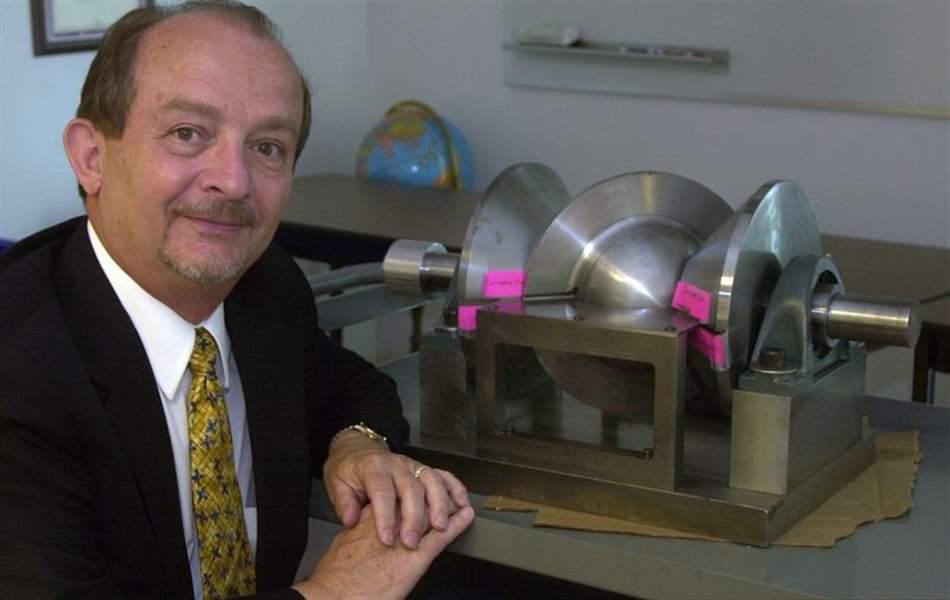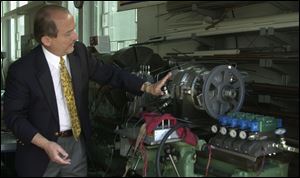
Cranking up a new engine
6/30/2002
Ron McMaster, with the lightweight spherical engine that has a round 'wobble plate.'
BLADE

Ronald McMaster shows a McMaster rotary engine being tested at the University of Toledo.
Ronald McMaster remembers when he and his prolific inventor father, Harold, hooked up their hydraulic-powered rotary engine to an AMC Ambassador car in the early 1970s.
The creation made promising pops and cracks - and spewed blue smoke - yet never ran on its own.
Thirty years and various less successful attempts by the McMaster clan later, so-called “proof-of-concept” models of their latest rotary engine design are being tested in laboratories at the University of Toledo and in San Antonio to show whether the device works.
The spherical, two-cycle engine about the size of a basketball is hidden in a drum-like housing, within which a round “wobble plate” essentially works as a piston. The engine has just two moving parts, and eight parts in all. One version being tested is expected to have power equivalent to a car's V-6 engine but has one-tenth the weight.
“About every decade there's a new concept, and this last one, I think, is the simplest one of them all,” said Ronald McMaster, president of McMaster Motor Co., a Toledo company, which is based in UT's Nitschke Hall.
The private company, which has five employees and is far from its first sale, was founded to develop a usable and efficient rotary engine. It is designing a fully built version to essentially run on steam from hydrogen and oxygen and which would have one environmentally friendly emission: water.
First, though, McMaster Motor must attract investors to bring testing for the innovation to the next level. The fledgling firm hopes that, in a quest for funding starting in the next month or so, it also can fuel some interest from manufacturers.
In the car-sized version, the hydrogen-and-oxygen engine would have at least 400 to 440 horsepower, equivalent to a V-8 engine and at least twice that of its gasoline-powered twin, Mr. McMaster said.
Still, such an engine isn't likely to wind up in a car anytime soon, Mr. McMaster admitted. The creation is far from being ready for production, and supplying hydrogen in cars is difficult. Non-automotive uses likely will come first, such as in power generators, but even that type of production is likely to be several years away, he added.
Internal combustion engines have dominated the auto industry for a century, and automakers are developing and, in some cases, selling alternatives involving electric hybrids and fuel cells.
Mazda Motor Co. has backed rotary engines for decades and is to use one in the upcoming RX-8 sports car, but it is powered by gasoline.

Ron McMaster, with the lightweight spherical engine that has a round 'wobble plate.'
The McMaster engine design is vastly different than the widely used Wankel rotary concept that Mazda uses. The gasoline-powered, four-cycle Wankel engine first successfully developed by Felix Wankel in the 1950s has two three-sided rotors that revolve in housings and produce power in a continuous stream.
Hydrogen, though, is the fuel of the future, one expert said. And while they may be hard to get serviced, rotary engines have a better weight-to-horsepower ratio than gasoline-powered internal combustion engines, said Frank Hampshire, research director with the Motor & Equipment Manufacturers Association in Research Triangle Park, N.C.
“There's probably a lot of room” for hydrogen inventions, he said. “That's where it's going to go.”
By the end of July or so, McMaster Motor expects to have worked out what size engine it will concentrate on first, depending on what market has the most promising demand and profit margins. The firm also is testing a coffee can-sized engine model that could run generators, be an outboard motor, or be built in wheel hubs of hybrid cars, Mr. McMaster said.
Then, the company will seek a few million dollars from investors and venture capitalists and start approaching manufacturers to hopefully establish a partnership.
Eventually, the company wants to license the technology to different manufacturers for specific purposes and to provide them with technical support.
For now, the local firm relies heavily on contractors, as well as UT students and staff, to help prove the invention even works. How well it works will be tested in the next phase.
Most of the funding so far has come from Harold McMaster, who has invested $10 million into the venture and began exploring alternatives six decades ago.
A renowned inventor who has started three companies locally, he refocused his efforts on the rotary engine after the controlling interest in what is now First Solar LLC with a plant in Perrysburg Township was sold in 1999.
Harold McMaster has another company, McMaster Fuels Ltd., that is examining the fuel side of the engine and considering solar panels to generate electricity, which could be combined with water to get hydrogen and oxygen.
Getting hydrogen and oxygen delivered for the engine is a problem, Ronald McMaster said. Using water is an option, he said.
“Right now we're looking for other ways to create steam other than just hydrogen and oxygen,” he said.
The company's chairman and chief executive, Harold McMaster, keeps close track of the testing being run locally by Chris Michalski, who did his master's thesis at UT on the engine and is the company's chief engineering analyst. Harold McMaster and his brother, Robert McMaster, were awarded a U.S. patent for the engine's design in May.
“His typical question is `Has it run yet?' We haven't answered that question yet,” Ronald McMaster said with a laugh last week.
At UT, a version of the large engine being tested is powered with hydraulics for now, but it should be using gasoline next month.
At a contractor's laboratory in San Antonio, a hydrogen-and-oxygen model is close to running on the gases.
Like a computer program, Mr. McMaster said, “this thing isn't going to run until everything is right.”
There are a lot of engine designs and prototypes that never make it beyond the initial stages.
Engine consultant Evan Guy said he had to visit Toledo to see the McMaster concept, a three-dimensional model.
“It took me a while really to, I guess, pick up on the process,” said Mr. Guy, a McMaster Motor contractor working with a hydrogen-and-oxygen version of the engine at Evan Guy Enterprises, Inc., in San Antonio.
The big advantage of the McMaster hydrogen-and-oxygen engine is that it is sealed and does not require air for combustion, Mr. Guy said.
Air-breathing engines produce oxide of nitrogen, which contributes to urban smog and acid rain, he said.
“Really, the only product of this engine is pure water,” Mr. Guy said.
Besides environmental benefits, the McMaster engine gives a lot of power in a small and lightweight package and can be scaled to different levels, said Nagi Naganathan, professor and interim dean at UT's College of Engineering.
“This is a novel concept that gives you benefits in so many areas that are important,” he said.
“Here is an engine that can be modified to run on different types of fuels.”